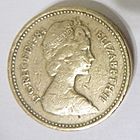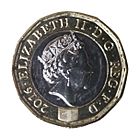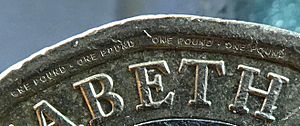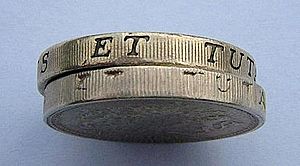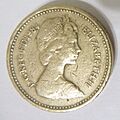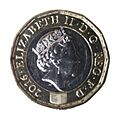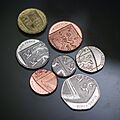One pound (British coin) facts for kids
| United Kingdom | |
| Value | £1 |
|---|---|
| Mass | 8.75 g |
| Diameter | 23.03–23.43 mm |
| Thickness | 2.8 mm |
| Edge | Alternately milled and plain |
| Composition | Outer ring: Nickel-brass (76% Cu, 20% Zn, and 4% Ni) Inner planchet: Nickel-plated alloy |
| Years of minting | 2016–present |
| Obverse | |
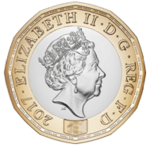 |
|
| Design | Queen Elizabeth II |
| Designer | Jody Clark |
| Design date | 2016 |
| Reverse | |
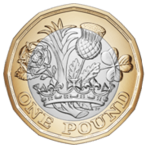 |
|
| Design | Rose, leek, thistle, and shamrock encircled by a coronet |
| Designer | David Pearce |
| Design date | 2016 |
The British one pound (£1) coin is a type of money used in the United Kingdom. It has a special engraving on one side that says 'Elizabeth II, by the grace of God, Queen, Defender of the Faith'. This coin has shown the face of Queen Elizabeth II since it was first made on April 21, 1983. Over time, four different pictures of the Queen have been used. The newest design was created by Jody Clark in 2015.
The current £1 coin has 12 sides. Its back design shows four symbols that represent the different parts of the UK. These are the English rose, the leek for Wales, the Scottish thistle, and the shamrock for Northern Ireland. These symbols grow from a single stem inside a crown. In May 2022, the Royal Mint announced that a new £1 coin would be made in 2023. This new coin will celebrate the history of the UK in the 21st century.
The original round £1 coin took the place of the paper £1 note. The paper notes stopped being made in 1984 and were removed from use in 1988. However, you can still exchange old paper notes at the Bank of England. Some places like Jersey, Guernsey, and the Isle of Man still use £1 paper notes, but the coin is much more common. A new 12-sided coin was introduced on March 28, 2017. Both the old and new coins were used together for a while. The old round coin was removed from circulation on October 15, 2017.
The main reason for making a new coin was to stop fake coins from being used. In 2014, about 3% of the old round £1 coins were fake. The new 12-sided coin is made of two different metals, like the £2 coin. It also has a secret security feature called "iSIS." This makes it much harder to copy.
The current 12-sided £1 coins are considered "legal tender." This means they must be accepted when paying off a debt. However, for everyday shopping, shops can choose which types of payment they accept.
Contents
Coin Design and Features
So far, four different pictures of Queen Elizabeth II have been on the front of the £1 coin. The words around her picture usually include 'ELIZABETH II D.G.REG.F.D.' and the year the coin was made. This means 'Elizabeth II, by the Grace of God, Queen, Defender of the Faith.'
Here's a quick look at the different portraits:
- In 1983 and 1984, the Queen's portrait by Arnold Machin was used. She wore a special tiara.
- From 1985 to 1997, a portrait by Raphael Maklouf was featured. In this one, the Queen wore a different crown.
- Between 1998 and 2015, the portrait by Ian Rank-Broadley was used. She wore the same tiara as in the first design.
- In 2015, the portrait by Jody Clark was introduced. The Queen wore the same crown as in the second design.
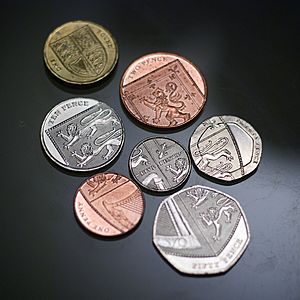
In 2005, the Royal Mint held a competition to design the backs of all UK coins. The winner was Matthew Dent. His designs, which started appearing in 2008, show parts of the Royal Shield. When you put the 1p, 2p, 5p, 10p, 20p, and 50p coins together, they form the whole shield. The £1 coin showed the complete shield.
The design on the back of the original round £1 coin changed every year from 1983 to 2008. Each year, it showed a symbol for the UK, Scotland, Wales, Northern Ireland, or England. From 2008, these national designs were still made, but not in a strict order. All £1 coins also had the words "ONE POUND" on the back.
The new 12-sided £1 coin, which came out in 2017, also has a special design on its back. This design was chosen through a public competition. A 15-year-old boy named David Pearce won the competition in 2015. His design shows a rose, leek, thistle, and shamrock, all tied together by a crown.
What is Legal Tender?
Current £1 coins are called "legal tender." This term has a very specific meaning. It means that if you owe someone money, they must accept these coins as payment for that debt.
However, "legal tender" does not mean that a shop has to accept a certain type of money. Shopkeepers can choose what kind of payment they want to take. For example, a shop might not accept a £50 note, even though it is legal tender.
Stopping Fake Coins
One of the biggest reasons for the new £1 coin was to fight against fake coins. In the last few years that the old round pound was used, many fake coins were found. In 2013, it was thought that over 3% of all £1 coins in circulation were fake.
It is against the law to knowingly use a fake coin. If you think you have a fake coin, you should give it to the police. They will keep it and investigate. Many banks did not always check for fake coins, so they sometimes put them back into circulation by mistake.
Some fake coins were easy to spot because they looked poorly made. They might have blurry details, bad edges, or the wrong color. Better fake coins were harder to tell apart. One way to check was to see if the front and back designs lined up correctly. On real UK coins, they should always face the same way. Also, the design on the back had to match the year it was made.
Fake coins are made in different ways, like casting or stamping. Most fake £1 coins were made of a metal similar to the real ones. Some were made of lead or tin and then painted gold.
The last round £1 coins were made in December 2015. The new 12-sided coin was introduced in 2017. Its unique shape, similar to an old brass threepence coin, and its two-metal design make it much harder to copy. It also has a secret security feature called "iSIS." This is thought to be a hidden code in the coin's metal that can only be seen under special ultraviolet light.
The £2 coin, which is also made of two different metals, is still harder to fake than the old round pound was. Fake £2 coins often have the wrong colors, making them easy to spot.
Other Pound Coins in Circulation
While the round £1 coin was still used in the UK, some other £1 coins from places like Gibraltar and the British Crown Dependencies (like Jersey and Guernsey) also circulated. These coins were usually the same size and made of the same materials as the UK £1 coin. They also showed the UK monarch's portrait.
After the UK changed its £1 coin, most of these other places did not immediately change theirs. However, Gibraltar still uses its own £1 coins alongside the new UK £1 coins.
See also
- Banknotes of the pound sterling
- Coin counterfeiting
- Coins of the pound sterling
Images for kids


